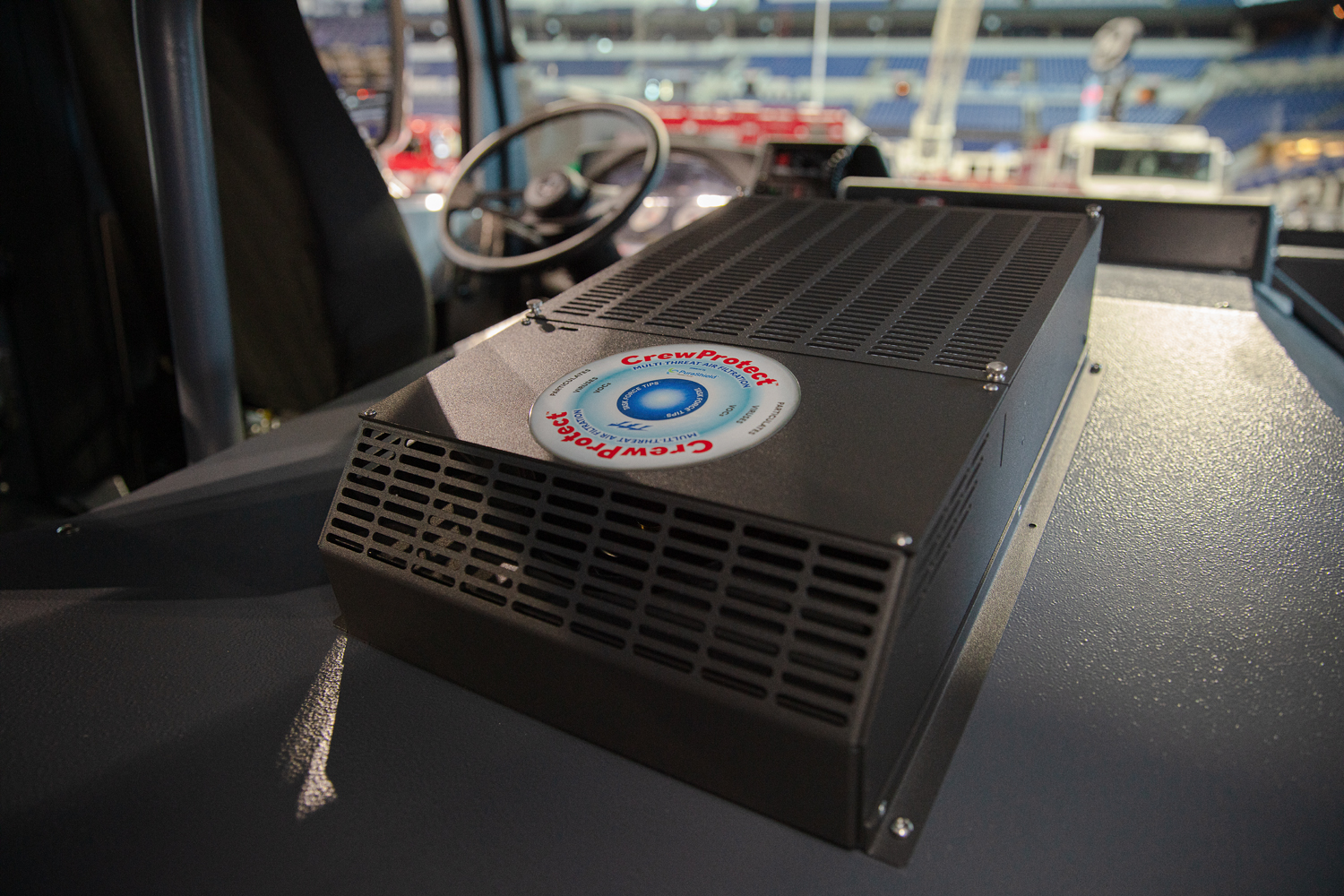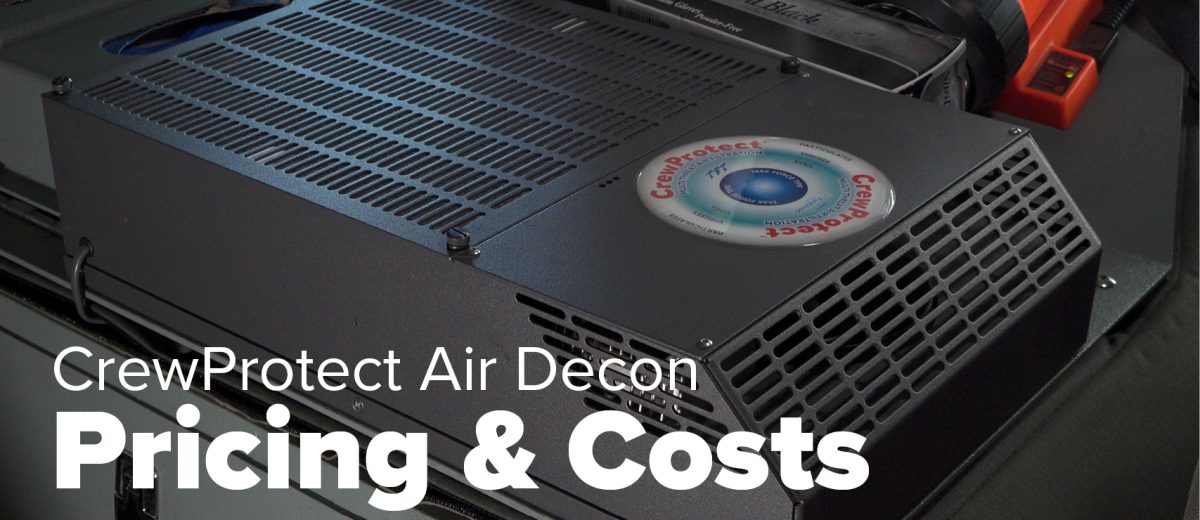What Does a CrewProtect Air Decontamination System Cost?
If you are considering a CrewProtect, you have likely wondered about the initial cost and other long-term costs of owning the system. Let’s look at some of those factors and what can affect the total cost of your CrewProtect and its competing systems.
What is the Initial Cost of CrewProtect?
Your initial cost for the CrewProtect air decontamination system will depend on a few factors. The first consideration is how many systems you plan to buy. Each apparatus needs its own unit, but you may choose to outfit one, a few, or all your vehicles at the same time.
Once you figure out how many vehicles you will be buying a unit for, you need to decide which CrewProtect unit is right for each vehicle. CrewProtect comes in 3 sizes. CrewProtect 100 is a 100 CFM (Cubic Feet per Minute) unit intended for use in larger apparatus. This unit was designed to clean roughly 350 cubic feet or the average space of an eight-passenger fire apparatus. CrewProtect 50 is a 50 CFM unit intended for use in small-medium vehicles or apparatus like a type 3 wildland vehicle or ambulance. The CrewProtect 20 is a 20 CFM unit meant for tiller cabs, Chief’s vehicles, or other enclosed vehicle spaces of roughly 50 cubic feet or smaller. This is comparable to your average SUV-type vehicle.
You will need to calculate the cubic footage of your vehicle? Use length X width X height to get a rough estimate of cubic footage.
CrewProtect 20 sells for around $1,035.00 USD. CrewProtect 50 sells for roughly $1508.00 USD. CrewProtect 100 sells for around $1,924.00 USD. Each of these includes the first cartridge for the unit. We’ll dig into the replacement costs of your cartridges later in this article.
The next cost factor is installation costs. Costs for installation can vary based on where you’re located and who you use to install the unit. CrewProtect can be installed in a new apparatus straight from the OEM or be retrofitted into an in-service apparatus. A qualified mechanic or service center can easily install the unit in a short amount of time.
The unit can be mounted virtually anywhere, though we recommend the ceiling, doghouse, or wall. Installation involves just four screws to hold the unit in place and two wires that connect to the ignition. This is what powers the unit on and off with the vehicle. The simplicity of installation makes it easy to install for any qualified mechanic.
What are the Ongoing Costs of Owning a CrewProtect?
Each CrewProtect needs a new cartridge after six months of use. Each cartridge comes sealed in a plastic bag that keeps the internal media from activating. Once this bag is opened, certain elements of the technology start to work even without the system running. During those six months of use, you have the same level of protection on day 183 as you did on day one.
You will know when your cartridge needs replaced thanks to an easy-to-read system of lights on the unit. A blue light means the cartridge is ok. When it changes to amber (around the 5-month mark), your cartridge needs to be replaced soon. Once the light changes to red, the cartridge has reached the end of its life and the system will not power on until the cartridge is replaced.

Watch how easy it is to change your cartridge!
Does the CrewProtect Come with a Warranty?
Each CrewProtect unit comes with a limited 3-year warranty, valid from the date of purchase. This warranty covers defects in material and workmanship for three years.
How Much do Competing Systems Cost?
CrewProtect has a couple of competing systems on the market that use different technologies. Let’s look at the approximate costs of buying and owning these systems.
Needlepoint Bipolar Ionization (NPBI™) for Fire Apparatus
One of the popular competing systems uses Needlepoint Bipolar Ionization (NPBI™) technology. This system emits specifically charged ions into the air. The system mounts in the vehicle similarly to CrewProtect.
Notably, this system does not include a filter to capture particulates or elements that have combined through the ionization process. This means these elements stay airborne until captured by another filter or they fall to surfaces, potentially leaving your crew exposed to harmful contaminants and the byproducts of particle combination.
The initial cost of purchase for systems using this technology is roughly $2,200.00. If the unit hardwires into your apparatus, you will see similar installation fees as the CrewProtect. Since there is no filter or other forms of consumable media, there are no ongoing costs associated with owning the system.
Notably, the company that patented NPBI technology faced a class action lawsuit claiming that the technology made the air quality worse. You can read about that lawsuit here.
Photohydroionization for Fire Apparatus
Photohydroionization and UV technology distribute H2O2 in the cab and sanitize the air and some hard surfaces. Systems using this technology also mount inside your apparatus cab.
Air decontamination systems using this technology also lack a filter to capture particulates, volatile organic compounds (VOCs), or other elements that cannot be neutralized by the H2O2. One system marketed to the fire service comes with a warning label stating that it is not intended for fire ground contaminants.
The initial cost of purchase is around $1,700. As with the CrewProtect and other air filtration and decontamination devices, you may see the cost associated with having the unit installed by a mechanic or service center. This technology requires a bulb to be changed annually. This bulb currently costs around $291.
What’s next?
Now that you know the cost of CrewProtect, and systems using technology that does not include a filter, you may be ready to see it in action. Find the dealer nearest you.
